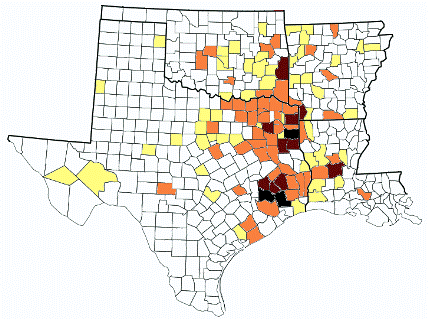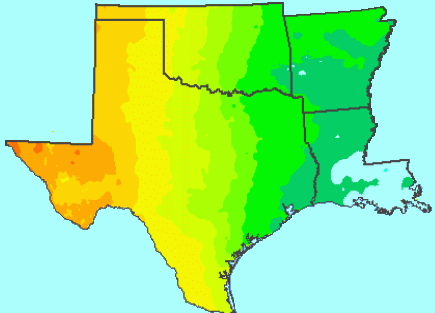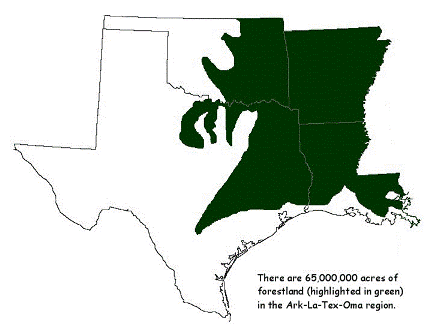 |
| "North American Wood Ape" as posted by "The Naturalist", probably not intended seriously |
[There seems to be a Cryptid in Texas that is the exact equivalent of the Florida Skunk Ape as an ape. There is also one that is the exact equivalent of the more Neanderthal-like Skunk Ape. In this case the Texans are speaking of the more apelike kind.-DD]
Support the TBRC
Wood Ape Sightings: Correlations to Annual Rainfall Totals, Waterways, Human Population Densities and Black Bear Habitat Zones
By Daryl Colyer & Alton Higgins
In Texas, Oklahoma, Arkansas and Louisiana, anecdotes about huge, hairy, apelike creatures said to dwell in the deep woods and, occasionally, near the peripheries of rural communities, have accumulated for centuries. Many of these accounts were related by highly reliable and trustworthy individuals, people who had nothing to gain by telling their stories.Indeed, in many cases, these witnesses became the subjects of much ridicule, even among close friends and relatives. To the present day, most witnesses hesitate to share their incredible stories of seeing this strange, undocumented animal. Their reticence should come as no surprise given the treatment of the subject by the mass media and some mainstream scientists.
There are many skeptics; their concerns are legitimate. Skeptics demand to know why no skeletal remains have been found; they want to know why no hunters have killed one, or why no driver has collided with one on a secluded country highway. Would not a large primate, skeptics ask, leave an undeniable, discernable mark on the environment in perhaps the same manner as mountain gorillas (Gorilla gorilla beringei)? Such questions are not invalid. Expecting skeptics to accept the likelihood of such a species existing beneath our proverbial noses may be asking just a tad too much. Nevertheless, the body of anecdotal accounts and accompanying evidence seems to indicate just such a possibility.
Contrary to what some may assert, most hunters do not generally shoot at anything other than their intended game. While there are exceptions, most hunters will definitively identify their targets and normally just do not shoot at unknown or unidentified prey. That said, there have been a few scant reports of wood ape shootings; most were relayed through second hand sources. Further, most of those few reports that were related to shootings indicate that the shooters either missed or did not immediately bring the fleeing wood apes down.
Skeletal remains are rarely found of any common, large, wild animal, so it should not be surprising that the skeletal remains of a wood ape are not readily available. The acidic forest soils and muddy river bottoms found in the preferred habitat for the wood ape tend to work in tandem with scavengers to quickly eliminate the remains of deceased animals. Finding a cougar (Puma concolor) carcass as a result of a natural death would probably be most analogous to finding a wood ape carcass, although the most conservative estimates of cougar population densities most certainly are far greater than even the most liberal estimates of wood ape population densities.
There have been a few unsubstantiated reports of near misses of wood apes by drivers, and given the probability that many encounters go unreported, it is possible that a wood ape could have been hit and killed by a moving vehicle. However, realistically, given the probable rarity of these creatures along with their intelligence and caution, the odds of such an event occurring seem almost non-existent.
There are some discernable signs that possibly indicate the presence of wood apes (thus the noticeable effect on the environment), however, the signs are easily disregarded by someone unfamiliar with purported wood ape behavior. For example, there are numerous reports of wood apes breaking branches, trees, and saplings, and to a lesser degree, constructing nest-like structures.
Tree damage, possibly done for the purpose of marking trails or territory is discernable, but oftentimes hardly stands out among deadfall and ice or wind-broken trees. Most people would miss or casually dismiss such signs. It is unlikely that a typical wildlife biologist or anyone not knowledgeable on this subject, upon observing wood ape-related limb breaks, would ever suspect a wood ape as the culprit, even in the absence of any other readily apparent explanation. The characteristic twisting accompanying such breaks would appear to require enormous strength that can only be accomplished by something with hands. Nest-like structures, purportedly built by wood apes, have been found by researchers in areas of sightings.
Another contention often heard is that the thousands of credible reports from throughout North America are, in one way or another, the products of human imagination. The contention is that many of the witnesses are intentionally lying about what they encountered and are actually themselves the perpetrators of hoaxes, or the witnesses are simply mistaken and are misidentifying what they saw or heard. Or, as the argument goes, many of the witnesses are simply victims of practical jokes and/or hoaxes. All evidence aside, it may seem more plausible to consider that there actually is an undocumented animal that is prompting thousands of reports than it is to believe in an unrelated series of hoaxed sightings and misidentifications.
It should soon become evident to anyone who seriously and objectively delves into and studies the numerous credible sightings that many of the reports themselves are quite compelling. It is difficult to totally dismiss as fabrications all the reports that have accumulated from so many credible witnesses over so many decades.
However, the essence of the research presented here does not focus on the validity of any individual report, but on the body of reports as a whole in order to ascertain any correlations and patterns that may exist. When one impartially studies the sum total of all the reports it becomes evident that there do indeed seem to be correlations and patterns that could be representative of a living species.
Among these correlations, particularly in Texas, is the likelihood of sighting reports in areas with certain amounts of annual rainfall. The same pattern is also evident in the body of reports that originate in other states where there are divergent rainfall totals in different parts of each state, such as Oregon, Washington, Oklahoma, New Mexico, Montana, Colorado and California. (Conversely, in states with widespread abundant rainfall totals, such as Arkansas and Louisiana, a rainfall total/reported bigfoot encounters correlation is not evident). There is also a pattern of reported sightings along rivers, creeks or lakes. Reported sightings and human population densities seem to have some correlation, as does the distribution of alleged bigfoot sightings and areas viewed as suitable black bear habitat.
John Green, journalist, author and renowned wood ape researcher, first touched upon the association of reported wood ape or "sasquatch" sightings and annual rainfall totals in his 1978 book Sasquatch: The Apes Among Us. Though the book was written nearly thirty years ago, the passage of time has not diminished its relevance. On the contrary, the increase of credible reports since that time has served to further validate Green’s thesis. He determined that eighty percent of the reported sightings and alleged footprint finds in North America occurred in areas receiving more than seventeen inches of annual rainfall.

The darker counties are where the higher concentrations of credible reported encounters have occurred.

From west to east, annual rainfall totals increase to as high as 70 inches in extreme eastern Louisiana.
The combined total amount of forestland in the four-state region equates to roughly 65,000,000 acres, or 100,000 square miles (the size of the state of Oregon). According to The Online Handbook of Texas, there are roughly 22,000,000 acres of forest in Texas alone; per the Arkansas Forestry Association, there are roughly 19,000,000 acres of forest in Arkansas; the Louisiana Forestry Association reports that there are 14,000,000 acres of forest in Louisiana; Oklahoma has approximately 10,000,000 acres of forest as indicated by the Oklahoma Department of Agriculture, Food and Forestry.

There are 65 million acres of forestland in the four-state region, which is about 100,000 square miles, or the size of the state of Oregon.
Almost without exception, reported wood ape sightings occur near water. This is even true with the relatively few reports originating in the drier regions of Texas and Oklahoma, where wood apes are reportedly seen generally on or near waterways or lakes in thick brush or dense riparian vegetation. Most wildlife researchers and hunters would quickly reinforce the observation that many mammalian species often use rivers and creeks as travel routes. Since water is essential for the cycle of life, animals regularly congregate near or at least dwell primarily in areas featuring bodies of fresh water. Both Texas and Oklahoma have an abundance of rivers, creeks, swamps, reservoirs and lakes, particularly in their eastern regions. It is also reasonable for a large number of reported sightings to occur in or around swamps, river bottoms or bayous, since a reclusive, shy animal would find seclusion and sanctuary in such areas.
When a river basins map is viewed with an overlay of reported encounters and an annual rainfall overlay, it becomes evident that most alleged sightings have occurred along waterways and lakes and in areas with thirty-five inches or more of annual rainfall. Many reported sightings in Northeast Texas have occurred in the Red River Basin along the Sulphur River or Red River and/or their adjoining reservoirs or creeks. Many reported encounters have also occurred in the Red/Sulphur River watershed in southeastern Oklahoma, southwestern Arkansas and Northeast Texas. Similarly, the Sabine River Basin, extending from Southeast Texas into Northeast Texas has also generated quite a few reports. In Oklahoma, the Canadian River Basin is not without its share of reported encounters. In Southeast Texas, in what is called the Primitive Big Thicket (encompassing the Sam Houston National Forest and the Big Thicket National Preserve area), the Neches River Basin, Trinity River Basin and San Jacinto River Basin have had many reports through the years as well as in recent times. In fact, Southeast Texas is the most prolific area in Texas for reports of bigfoot sightings. Likewise in Oklahoma, the most prolific area for reported encounters is also in its southeastern region. It should come as no surprise that the southeastern regions in both Texas and Oklahoma also receive the highest amount of rainfall for both states, with totals as high as sixty inches per year in spots.
Although the East Texas river basins have generated far more reports, the Brazos, Colorado and Guadalupe basins have also had occasional reported sightings. These three basins average less than thirty-five inches of rainfall per year, but they typically have dense vegetation and trees in the riparian margins. Given that the vast majority of Texas and Oklahoma reports follows rainfall patterns and occurs along waterways, the notion that these reports are simply the result of the misidentification of known animals, wishful thinking, and/or deliberate fabrications seems flawed.
There is yet another interesting correlation with the distribution of these sighting reports. For the most part it appears that most reported sightings in the four-state region occur in counties with lower human population densities. There are a few exceptions. However, 100% of the sightings reported from counties with higher populations still occurred in areas that were along the peripheries of or outside of the realm of human development (such as in Montgomery County, Texas, in the Sam Houston National Forest, an area of consistent reports). Actually, suitable wildlife habitat often exists close to urban and suburban areas. That being said, reported sightings that have occurred on the edge of small towns and larger cities are by far the exceptions.
In fact, it seems that where human populations increase, reported wood ape sightings decrease. Where human populations decrease, reported ape sightings may increase. The reputed shyness of the wood ape is only further girded by this human population correlation. This observation is further enhanced by the inference from reports that wood apes are nocturnal, or at the very least, crepuscular. Not only do the reported sightings seem to suggest that wood apes live in areas of low human population densities, along waterways, and in areas of high annual rainfall, but they may be most active when humans are not, which is at night. The notion of fabrications and mistakes is unrealistic in light of these correlations.
While Oklahoma, Arkansas and Louisiana have resident populations of black bears (Ursus americanus), there remains the question of whether or not the 12,000,000 acres of dense forest in East Texas can support even a small population of large omnivores such as the wood ape. After all, black bears no longer roam the Piney Woods of East Texas. But did black bears disappear from East Texas because of a shortage of suitable habitat? No, or so says the Texas Parks and Wildlife Department. Biologists conducted a black bear habitat suitability study in four areas of East Texas: the Sulphur River Bottom (51,000 acres), the Big Thicket National Preserve (97,000 acres), the Middle Neches River Corridor (247,000 acres), and the Lower Neches River Corridor (312,000 acres). The purpose of the study was to determine the suitability of habitat in East Texas for the black bear, a large omnivorous mammal. The study is relevant because there may be a correlation between purported wood ape and suitable black bear habitat. If an area is suitable for a large omnivore such as the black bear, it seems reasonable to posit that it is just as likely to be suitable for a small population of omnivorous wood apes.
One part of the study dealt with food availability in summer and winter; all four areas scored very high. Biologists calculated a strong favorable rating for the availability of protection and concealment cover in all four areas. In the category of human/bear conflict zones, a less than favorable rating for the Big Thicket National Preserve was determined, but a moderately to strongly favorable rating was found for the other three areas.
Overall, the study indicated that the most suitable region for bears among the four study areas was the Middle Neches River Corridor, followed in order by the Lower Neches River Corridor, the Sulphur River Bottom, and the Big Thicket National Preserve. All four areas have had an abundance of bigfoot sighting reports.
Environmental suitability issues were also addressed by another group of scientists. While the curators of Chimp Haven in Northwest Louisiana probably do not spend too much time contemplating black bear habitat factors, they do devote much of their time discussing and evaluating primate habitat. According to their web site, Chimp Haven provides a permanent home for chimpanzees (Pan troglodytes) retired from biomedical research, the entertainment industry, and those no longer wanted as pets. Their new sanctuary, presently under construction, is planned to accommodate 300 chimpanzees, animals which may be the closest relatives of wood apes. Due to its ecology and climate, Chimp Haven curators believe that Northwest Louisiana is ideal primate habitat. Western Louisiana and East Texas are virtually ecological clones. It should come as no surprise that Northwest Louisiana was selected as the new site of Chimp Haven’s operations, given what we believe about wood ape habitat.
In conclusion, several observations serve to dispel the notion that bigfoot sighting reports in Texas and Oklahoma are not the result of actual encounters. The reports, based on recent as well as older credible encounters, continue to accumulate and show no signs of abating. If one chooses to take the reports seriously and the apparent associated ecological patterns, as has been done in this paper, debates regarding the existence of this species are replaced by new issues such as those pertaining to ecology, distribution, behavior, and population densities.
References
Alley, J. Robert (2003). Raincoast Sasquatch. 351 pp. Hancock House, Blaine, Washington.
Bindernagel, J.A. (1998). North America's Great Ape: The Sasquatch. 270 pp. Beachcomber Books. Courtenay, B.C., Canada.
Chimp Haven.
Distribution of Precipitation in Oklahoma map. Provided by the online Web Atlas of Oklahoma.
Fahrenbach, W.H. (1997-1998). Sasquatch: Size, Scaling, and Statistics. Cryptozoology Vol. 13: 47-75.
Garner, Nathan P. and Sean Willis. (1997). Black Bear Habitat Suitability in East Texas, featured in Wildlife Research Highlights, pages 18-19 (.pdf). Texas Parks and Wildlife Department, Austin, Texas.
Gould Ecoregions of Texas map (.pdf). Provided by Texas Parks and Wildlife Department GIS Lab.
Green, J. (1978). Sasquatch: The Apes Among Us. 492 pp. Hancock House Publishers Ltd., Saanichton, B.C., Canada.
Natural Regions of Texas map (.pdf). Provided by Texas Parks and Wildlife Department GIS Lab.
Natural Subregions of Texas map (.pdf). Provided by Texas Parks and Wildlife Department GIS Lab.
Oklahoma Ecoregions map. Provided by the online Web Atlas of Oklahoma.
Population of Oklahoma map. Provided by the online Web Atlas of Oklahoma.
Precipitation in Texas map (.pdf). Provided by Texas Parks and Wildlife Department GIS Lab.
Surface Hydrography of Oklahoma map. Provided by the online Web Atlas of Oklahoma.
Texas River Basins, Major Bays and Streams map (.pdf). Provided by Texas Parks and Wildlife Department GIS Lab.
Texas Sightings Database. TBRC Report Explorer. Texas Bigfoot Research Conservancy.
The Vegetation Types of Texas map (.pdf). Provided by Texas Parks and Wildlife Department GIS Lab.
Vegetation in Oklahoma map. Provided by the online Web Atlas of Oklahoma.
Watersheds Across Oklahoma map. Provided by the online Web Atlas of Oklahoma.

No comments:
Post a Comment
This blog does NOT allow anonymous comments. All comments are moderated to filter out abusive and vulgar language and any posts indulging in abusive and insulting language shall be deleted without any further discussion.